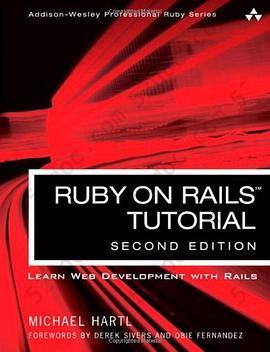注重体验与质量的电子书资源下载网站
分类于: 互联网 其它
简介

Ruby on Rails Tutorial: Learn Web Development with Rails 豆 9.1分
资源最后更新于 2020-07-27 14:51:45
作者:Michael Hartl
出版社:Addison-Wesley Professional
出版日期:2012-01
ISBN:9780321832054
文件格式: pdf
标签: Ruby RoR Rails 编程 web 计算机 programming rails
简介· · · · · ·
"Ruby on Rails(TM) Tutorial by Michael Hartl has become a must-read for developers learning how to build Rails apps." -Peter Cooper, Editor of Ruby Inside Using Rails, developers can build web applications of exceptional elegance and power. Although its remarkable capabilities have made Ruby on Rails one of the world's most popular web development frameworks, it can be challeng...
目录
Foreword to the First Edition by Derek Sivers xv
Foreword to the First Edition by Obie Fernandez xvii
Acknowledgments xix
About the Author xxi
Chapter 1: From Zero to Deploy 1
1.1 Introduction 3
1.2 Up and Running 9
1.3 Version Control with Git 27
1.4 Deploying 39
1.5 Conclusion 43
Chapter 2: A Demo App 45
2.1 Planning the Application 45
2.2 The Users Resource 49
2.3 The Microposts Resource 63
2.4 Conclusion 74
Chapter 3: Mostly Static Pages 77
3.1 Static Pages 82
3.2 Our First Tests 93
3.3 Slightly Dynamic Pages 103
3.4 Conclusion 114
3.5 Exercises 114
3.6 Advanced Setup 117
Chapter 4: Rails-Flavored Ruby 129
4.1 Motivation 129
4.2 Strings and Methods 134
4.3 Other Data Structures 142
4.4 Ruby Classes 153
4.5 Conclusion 164
4.6 Exercises 164
Chapter 5: Filling in the Layout 167
5.1 Adding Some Structure 167
5.2 Sass and the Asset Pipeline 187
5.3 Layout Links 197
5.4 User Signup: A First Step 211
5.5 Conclusion 215
5.6 Exercises 217
Chapter 6: Modeling Users 221
6.1 User Model 222
6.2 User Validations 236
6.3 Adding a Secure Password 254
6.4 Conclusion 267
6.5 Exercises 268
Chapter 7: Sign Up 271
7.1 Showing Users 271
7.2 Signup Form 292
7.3 Signup Failure 303
7.4 Signup Success 312
7.5 Conclusion 321
7.6 Exercises 321
Chapter 8: Sign In, Sign Out 325
8.1 Sessions and Signin Failure 325
8.2 Signin Success 343
8.3 Introduction to Cucumber (Optional) 363
8.4 Conclusion 371
8.5 Exercises 372
Chapter 9: Updating, Showing, and Deleting Users 373
9.1 Updating Users 373
9.2 Authorization 385
9.3 Showing All Users 396
9.4 Deleting Users 413
9.5 Conclusion 422
9.6 Exercises 424
Chapter 10: User Microposts 429
10.1 A Micropost Model 429
10.2 Showing Microposts 445
10.3 Manipulating Microposts 454
10.4 Conclusion 479
10.5 Exercises 480
Chapter 11: Following Users 483
11.1 The Relationship Model 484
11.2 A Web Interface for Following Users 503
11.3 The Status Feed 529
11.4 Conclusion 539
11.5 Exercises 543
Foreword to the First Edition by Obie Fernandez xvii
Acknowledgments xix
About the Author xxi
Chapter 1: From Zero to Deploy 1
1.1 Introduction 3
1.2 Up and Running 9
1.3 Version Control with Git 27
1.4 Deploying 39
1.5 Conclusion 43
Chapter 2: A Demo App 45
2.1 Planning the Application 45
2.2 The Users Resource 49
2.3 The Microposts Resource 63
2.4 Conclusion 74
Chapter 3: Mostly Static Pages 77
3.1 Static Pages 82
3.2 Our First Tests 93
3.3 Slightly Dynamic Pages 103
3.4 Conclusion 114
3.5 Exercises 114
3.6 Advanced Setup 117
Chapter 4: Rails-Flavored Ruby 129
4.1 Motivation 129
4.2 Strings and Methods 134
4.3 Other Data Structures 142
4.4 Ruby Classes 153
4.5 Conclusion 164
4.6 Exercises 164
Chapter 5: Filling in the Layout 167
5.1 Adding Some Structure 167
5.2 Sass and the Asset Pipeline 187
5.3 Layout Links 197
5.4 User Signup: A First Step 211
5.5 Conclusion 215
5.6 Exercises 217
Chapter 6: Modeling Users 221
6.1 User Model 222
6.2 User Validations 236
6.3 Adding a Secure Password 254
6.4 Conclusion 267
6.5 Exercises 268
Chapter 7: Sign Up 271
7.1 Showing Users 271
7.2 Signup Form 292
7.3 Signup Failure 303
7.4 Signup Success 312
7.5 Conclusion 321
7.6 Exercises 321
Chapter 8: Sign In, Sign Out 325
8.1 Sessions and Signin Failure 325
8.2 Signin Success 343
8.3 Introduction to Cucumber (Optional) 363
8.4 Conclusion 371
8.5 Exercises 372
Chapter 9: Updating, Showing, and Deleting Users 373
9.1 Updating Users 373
9.2 Authorization 385
9.3 Showing All Users 396
9.4 Deleting Users 413
9.5 Conclusion 422
9.6 Exercises 424
Chapter 10: User Microposts 429
10.1 A Micropost Model 429
10.2 Showing Microposts 445
10.3 Manipulating Microposts 454
10.4 Conclusion 479
10.5 Exercises 480
Chapter 11: Following Users 483
11.1 The Relationship Model 484
11.2 A Web Interface for Following Users 503
11.3 The Status Feed 529
11.4 Conclusion 539
11.5 Exercises 543








